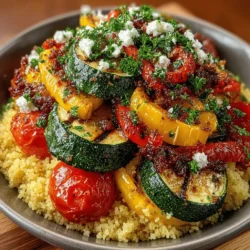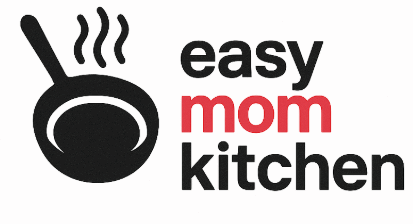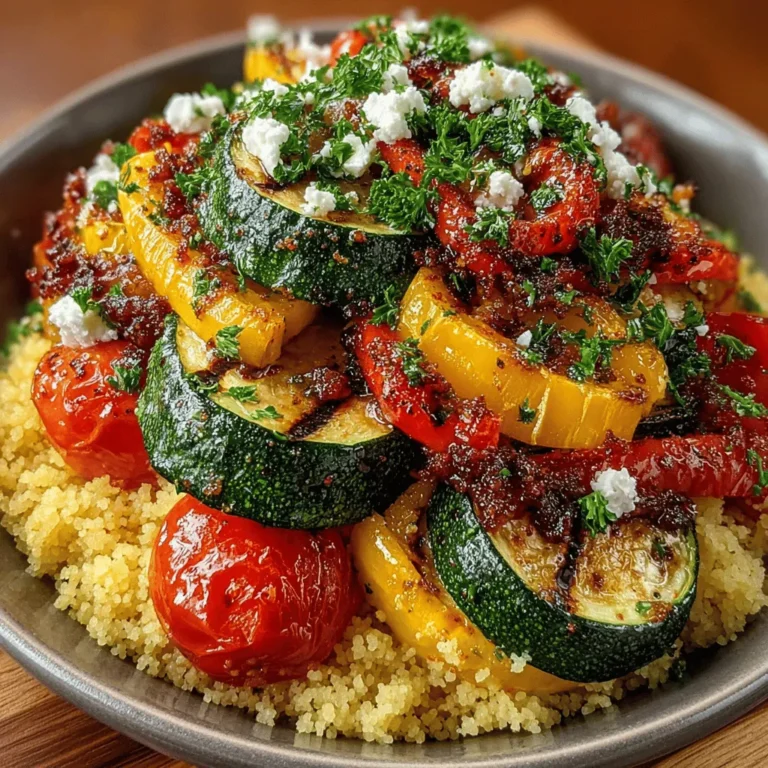Garlic Roasted Veggie Couscous: A Wholesome Delight
Garlic Roasted Veggie Couscous is more than just a meal; it’s a vibrant celebration of flavors and nutrition that appeals to both the eye and the palate. This dish combines fluffy couscous with a medley of roasted vegetables, bringing together a delightful array of textures and tastes. Whether you’re looking for a quick weeknight dinner or a colorful side dish to impress guests at your next gathering, Garlic Roasted Veggie Couscous is a versatile option that ticks all the right boxes.
The appeal of this dish lies not only in its visual charm but also in its health benefits. It features an abundance of vegetables that pack a nutritional punch—think colorful bell peppers, tender zucchini, juicy cherry tomatoes, and sweet red onions. These ingredients are not just there for their looks; they contribute vital vitamins, minerals, and antioxidants essential for maintaining good health. When paired with couscous—a whole grain—this dish provides a balanced meal that is both satisfying and nourishing.
Understanding Couscous and Its Versatility
Couscous, often mistaken for a grain, is actually a type of pasta made from semolina wheat. Originating from North Africa, it has become a staple in various cuisines around the world, thanks to its quick cooking time and ability to absorb flavors. There are several types of couscous, including Moroccan, Israeli (or pearl), and whole wheat varieties, each offering unique textures and tastes.
Nutritionally, couscous is a great source of carbohydrates, making it an excellent energy booster. Whole wheat couscous, in particular, offers additional fiber, which is beneficial for digestive health. Its versatility allows it to be used in a myriad of dishes—from salads and soups to hearty mains and side dishes—making it an essential pantry staple. By incorporating couscous into your meals, you can enjoy a nutritious base that complements a wide range of ingredients.
The Role of Vegetables in This Dish
In Garlic Roasted Veggie Couscous, the vegetables play a crucial role, not just in enhancing flavor but also in providing a range of nutritional benefits. Each vegetable contributes its unique set of vitamins and minerals, making this dish a wholesome choice.
– Bell Peppers: Rich in vitamin C and antioxidants, bell peppers add a sweet crunch and a pop of color to the dish. They are known for their anti-inflammatory properties and are a great addition to any diet.
– Zucchini: This summer squash is low in calories yet high in essential nutrients like vitamin A, potassium, and folate. Its mild flavor allows it to absorb the spices and garlic beautifully, enhancing the overall taste of the dish.
– Cherry Tomatoes: Bursting with flavor, cherry tomatoes provide a juicy contrast to the roasted veggies. They are an excellent source of lycopene, which has been linked to numerous health benefits, including heart health and skin protection.
– Red Onion: Offering a slightly sweet and sharp flavor, red onions are high in antioxidants and can help promote heart health. When roasted, they become tender and caramelized, adding depth to the dish.
For those looking to personalize their Garlic Roasted Veggie Couscous, the beauty of this recipe lies in its adaptability. Seasonal vegetables can be easily swapped in—think asparagus in the spring, squash in the summer, or root vegetables in the fall. This flexibility not only allows for creativity in the kitchen but also ensures that you can enjoy the dish year-round.
Flavor Enhancements: Garlic and Herbs
No dish is complete without the right balance of flavor, and in Garlic Roasted Veggie Couscous, garlic takes center stage. Known for its robust flavor and health benefits, garlic is a staple ingredient in many cuisines. It is praised for its anti-inflammatory and immune-boosting properties, making it a valuable addition to any meal. When roasted, garlic becomes mellow and sweet, infusing the vegetables and couscous with its rich aroma.
To elevate the dish further, we incorporate a blend of herbs and spices. Oregano, a classic Mediterranean herb, brings a hint of earthiness and pairs beautifully with roasted vegetables. Its antioxidant properties add another layer of health benefits. Smoked paprika, on the other hand, imparts a subtle smokiness that enhances the overall flavor profile, creating a dish that is both complex and satisfying.
Together, garlic, oregano, and smoked paprika transform Garlic Roasted Veggie Couscous from a simple side dish into a vibrant, flavorful centerpiece. The combination of these ingredients ensures that every bite is packed with taste, making it a perfect choice for both vegetarians and meat-eaters alike.
Initial Steps for Preparing Garlic Roasted Veggie Couscous
Now that you understand the appeal and health benefits of Garlic Roasted Veggie Couscous, let’s delve into the initial steps involved in preparing this delicious dish.
1. Gather Your Ingredients: Start by assembling your choice of vegetables, along with garlic, couscous, olive oil, and your selection of herbs and spices. Fresh herbs like parsley or basil can be used for garnish, adding a fresh touch to the final presentation.
2. Preheat the Oven: Set your oven to 400°F (200°C). Preheating the oven ensures that the vegetables roast evenly and develop that desirable caramelization, enhancing their flavor.
3. Prepare the Vegetables: Wash and chop your chosen vegetables into bite-sized pieces. This not only makes them easier to eat but also ensures they cook evenly. Toss them in a bowl with olive oil, minced garlic, and your selected herbs and spices. Make sure each piece is well-coated for maximum flavor.
4. Roast the Vegetables: Spread the seasoned vegetables evenly on a baking sheet, ensuring they are not overcrowded. This allows for better roasting and helps achieve that perfect golden-brown finish. Roast in the preheated oven for about 20-25 minutes, or until the vegetables are tender and caramelized.
5. Cook the Couscous: While the vegetables are roasting, prepare the couscous according to package instructions. Typically, this involves bringing water or broth to a boil, adding the couscous, covering it, and letting it steam for a few minutes. This step is quick and can be done simultaneously with roasting the vegetables.
By following these initial steps, you’ll be well on your way to creating a delightful Garlic Roasted Veggie Couscous that is sure to impress and nourish. Stay tuned for the next part of the recipe, where we will explore the final touches and serving suggestions that will take this dish to the next level.
{{image_2}}
The Cooking Process: Step-by-Step Breakdown
Preheating the Oven
Before you begin preparing your ingredients, it’s essential to preheat your oven to 425°F (220°C). Proper temperature control is crucial for roasting vegetables effectively, as it helps achieve that desirable caramelization while ensuring even cooking. When vegetables are roasted at the right temperature, they develop a rich flavor profile and a satisfying texture. Preheating the oven allows you to maximize these aspects, ensuring that your garlic roasted veggie couscous turns out perfectly every time.
Preparing the Vegetables
Selecting the right vegetables is key to the success of this dish. While you can use a variety of seasonal vegetables, some excellent options include bell peppers, zucchini, carrots, cherry tomatoes, and red onions. Here are some best practices for cutting and seasoning your vegetables:
1. Uniform Size: Cut your vegetables into uniform pieces, about 1-inch in size, to ensure they cook evenly. This will prevent some pieces from being overcooked while others remain crunchy.
2. Seasoning: In a large mixing bowl, toss your chopped vegetables with extra virgin olive oil, minced garlic, salt, pepper, and herbs of your choice, such as thyme or rosemary. This combination will enhance the flavor of the veggies and promote even roasting.
3. Even Coating: Make sure all vegetables are evenly coated with oil and seasonings. This not only adds flavor but also helps in achieving that golden-brown color during roasting.
Roasting Techniques
To achieve the perfect caramelization and texture in your roasted vegetables, follow these tips:
1. Single Layer: Spread your seasoned vegetables in a single layer on a baking sheet lined with parchment paper. Avoid overcrowding, as this can cause steaming instead of roasting, preventing that lovely caramelization.
2. Stir Occasionally: Roast the vegetables for about 25-30 minutes, stirring halfway through. This ensures that all sides of the vegetables get that beautiful golden-brown exterior.
3. Check for Doneness: Your vegetables are done when they are tender and golden. Depending on the vegetable type, cooking times may vary slightly, so keep an eye on them as they roast.
Cooking Couscous
Couscous is a versatile grain that serves as the perfect base for your garlic roasted veggie dish. Here’s how to cook it to achieve optimal fluffiness:
1. Boil Water: In a medium saucepan, bring 1 cup of water or vegetable broth to a boil. The broth will add extra flavor to the couscous.
2. Add Couscous: Once the water is boiling, stir in 1 cup of couscous. Remove the saucepan from heat and cover it with a lid. Let it sit for about 5 minutes. This resting period allows the couscous to absorb the liquid fully and puff up.
3. Fluffing: After the resting time, use a fork to fluff the couscous gently. This step is crucial for preventing clumps and ensuring a light, airy texture in your final dish.
Combining Flavors
Now that both the roasted veggies and couscous are ready, it’s time to combine them for a harmonious flavor profile:
1. Mixing: In a large bowl, combine the fluffy couscous with the roasted vegetables. Drizzle with a bit more olive oil and toss gently to distribute the ingredients evenly.
2. Adding Fresh Herbs: For enhanced freshness, consider adding a handful of chopped fresh herbs, such as parsley or cilantro. This not only elevates the flavor but also adds a vibrant pop of color to the dish.
3. Season to Taste: Taste your dish and adjust the seasoning if necessary. A pinch of lemon juice can brighten the flavors, making the dish even more delightful.
Serving Suggestions and Presentation
Once your garlic roasted veggie couscous is complete, it’s time to think about presentation:
1. Attractive Serving Dish: Serve the couscous in a large, shallow bowl or platter to showcase the vibrant colors of the roasted vegetables. A white or neutral-colored dish provides a beautiful contrast to the colorful veggies.
2. Optional Feta Cheese Topping: For an extra layer of flavor, consider crumbling feta cheese over the top of the couscous just before serving. The tangy creaminess of feta complements the roasted vegetables beautifully. If you or your guests are dairy-free, you can skip the cheese or use a vegan alternative.
3. Pairing Suggestions: This dish pairs wonderfully with a side of garlic bread or a light Mediterranean salad made with cucumber, tomatoes, and olives. You could also serve it alongside grilled chicken or fish for a heartier meal.
Nutritional Breakdown
Understanding the nutritional content of your dish is essential, especially if you’re health-conscious. Here’s a detailed look at what makes garlic roasted veggie couscous a nutritious choice:
– Per Serving: One serving of garlic roasted veggie couscous (approximately 1 cup) contains about 250 calories, 10g of protein, 9g of fat, and 35g of carbohydrates. It’s also rich in fiber, thanks to the vegetables.
– Health Benefits:
– Couscous: A great source of carbohydrates, couscous provides energy and is low in fat. It is also a good source of selenium, an antioxidant that plays a role in metabolism.
– Vegetables: The mix of roasted vegetables is packed with vitamins A and C, potassium, and antioxidants, all of which support overall health and well-being.
– Olive Oil: Rich in monounsaturated fats, olive oil is known for its heart-healthy properties and anti-inflammatory benefits.
– Feta Cheese: If included, feta cheese adds calcium and protein, although it’s higher in sodium.
– Dietary Needs: Garlic roasted veggie couscous is a fantastic option for vegetarians and aligns well with the Mediterranean diet, which emphasizes whole grains, healthy fats, and fresh produce. It can easily be modified to fit vegan diets by omitting cheese and ensuring no animal products are used in the broth.
Conclusion
Garlic roasted veggie couscous is more than just a side dish; it’s a delightful, health-conscious option that brings together vibrant flavors and textures. The combination of roasted vegetables and fluffy couscous creates a satisfying meal that can stand alone or accompany a variety of proteins.
This dish encourages creativity in the kitchen, allowing you to experiment with seasonal vegetables and personalize the flavors to suit your taste. Whether you’re preparing a weeknight dinner or entertaining guests, garlic roasted veggie couscous is sure to impress.
Don’t hesitate to experiment with your own vegetable combinations to make this dish uniquely yours. The joy of cooking lies in the ability to share home-cooked meals that nourish both body and soul. So gather your ingredients, follow the steps, and enjoy the wonderful flavors of this delicious recipe!


